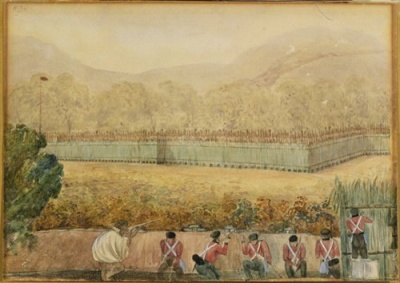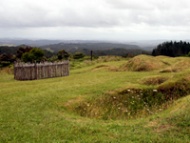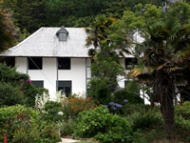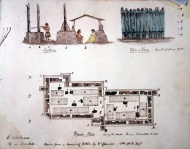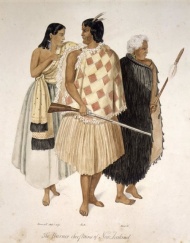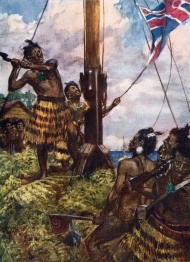Personal details
Full Name:
- Hōne Wiremu Heke Pōkai
Lifetime:
- ?–1850

Ngāpuhi chief Hōne Heke was an influential northern Māori voice in favour of the Treaty of Waitangi. However, he later became a leading opponent of British rule in New Zealand.
Read more...Events In History
-
 11 March 1845The fall of Kororāreka
11 March 1845The fall of KororārekaAfter hundreds of Ngāpuhi fighters led by Kawiti and Hōne Heke attacked Kororāreka (Russell), most of its inhabitants were evacuated by sea. The flagstaff on nearby Maiki Hill was cut down for the fourth and last time. Read more...
-
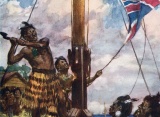 19 January 1845Hōne Heke cuts down the British flagstaff - again
19 January 1845Hōne Heke cuts down the British flagstaff - againThe first Māori to sign the Treaty of Waitangi, Ngāpuhi chief Hōne Heke Pōkai soon became disenchanted with the consequences of colonisation. Read more...
Articles
The Northern War

The Northern War, fought in the Bay of Islands in 1845-46, was the first serious challenge to the Crown in the years after the signing of the Treaty of Waitangi. Its opening shots marked the beginning of the wider North Island conflicts that are often referred to as the New Zealand Wars.
-
Page 2 – Origins of the Northern War
Actions by the colonial government cost Bay of Islands Māori trade and other opportunities. Heke feared that chiefly authority was now subservient to that of the British Crown
-
Page 3 – The sacking of Kororāreka
The sacking of Kororāreka (Russell) shook the settler population. About £50,000 worth of property was destroyed, and there was panic in Auckland. Some settlers sold their land
-
Page 4 – Puketutu and Te Ahuahu
Māori learnt an important lesson at Puketutu: the British were a formidable foe in open battle. This would influence Māori tactics in future clashes
-
Page 5 – Ōhaeawai
Keen to cash in on Heke’s setback at Te Ahuahu, Henry Despard assembled the largest British force yet seen in the colony and moved to attack Kawiti’s new pā at Ōhaeawai.
-
Page 6 – The quest for peace
George Grey became governor in November 1845. When talks with the 'rebels' broke down in early December, Grey ordered Despard to move against Kawiti's new pa, Ruapekapeka.
-
Page 7 – Ruapekapeka
Ruapekapeka may have been a tactical victory for the British, but many consider the outcome a draw. Heke and Kawiti had escaped with their forces largely intact, and the terms
-
Page 8 – Peace breaks out
Historian James Belich contends that Grey won the propaganda war and Kawiti and Heke won the real war. Others argue that Belich's revisionism goes too far and maintain that
New Zealand's 19th-century wars
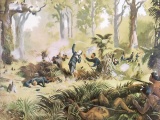
War changed the face of New Zealand in the 19th century. Many thousands of Māori died in the intertribal Musket Wars between the 1810s and the 1830s. There were more deaths during the New Zealand Wars of the 1840s to 1870s between some Māori and the Crown, which for many tribes had dire consequences.
- Page 2 - Pre-1860 conflictsDuring the Musket Wars of the 1810s-1830s thousands of Māori fled from their traditional lands, opening large areas to potential Pākehā (European) settlement. In 1840,
A frontier of chaos?
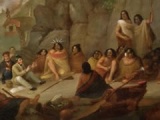
In the years before the signing of the Treaty of Waitangi, relations between Māori and Europeans were marred by a number of high-profile incidents.
- Page 7 - KororārekaThe missionaries divided the Europeans who came to New Zealand in the early 19th century into two groups: the agents of virtue (themselves) and the agents of vice (almost everyone
Related keywords
- ruapekapeka attack
- northern war
- roadside stories
- new zealand wars
- missionaries
- kororareka
- russell
- treaty of waitangi
- te ruki kawiti
- tamati waka nene
- george grey
- robert fitzroy
- kupapa
- painting
- cyprian bridge
- ōhaeawai
- maori pa
- hariata rongo
- joseph merrett
- maori leaders
- ngapuhi
- henry despard
- battle for puketutu
- 1840s
- musket wars
- hms hazard
- flags
- pre-1840 contact
- prostitution
- henry williams
- treaty signatories
- te reo māori
- declaration of independence
-
Main image: Hōne Heke's pā at Ōhaeawai
Cyprian Bridge's painting of Hōne Heke's pā at ŌhaeawaI

